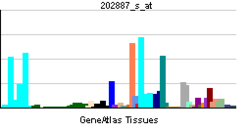- DDIT4
-
DNA-damage-inducible transcript 4 Identifiers Symbols DDIT4; Dig2; FLJ20500; REDD-1; REDD1; RP11-442H21.1; RTP801 External IDs OMIM: 607729 MGI: 1921997 HomoloGene: 10400 GeneCards: DDIT4 Gene Gene Ontology Molecular function • 14-3-3 protein binding Cellular component • intracellular
• cytoplasm
• mitochondrionBiological process • response to hypoxia
• apoptosis
• negative regulation of TOR signaling cascade
• protein complex disassembly
• negative regulation of glycolysisSources: Amigo / QuickGO RNA expression pattern 
More reference expression data Orthologs Species Human Mouse Entrez 54541 74747 Ensembl ENSG00000168209 ENSMUSG00000020108 UniProt Q9NX09 n/a RefSeq (mRNA) NM_019058 NM_029083.2 RefSeq (protein) NP_061931 NP_083359.1 Location (UCSC) Chr 10:
74.03 – 74.04 MbChr 10:
59.41 – 59.41 MbPubMed search [1] [2] DNA-damage-inducible transcript 4 protein is a protein that in humans is encoded by the DDIT4 gene.[1][2]
References
- ^ Shoshani T, Faerman A, Mett I, Zelin E, Tenne T, Gorodin S, Moshel Y, Elbaz S, Budanov A, Chajut A, Kalinski H, Kamer I, Rozen A, Mor O, Keshet E, Leshkowitz D, Einat P, Skaliter R, Feinstein E (Mar 2002). "Identification of a novel hypoxia-inducible factor 1-responsive gene, RTP801, involved in apoptosis". Mol Cell Biol 22 (7): 2283–93. doi:10.1128/MCB.22.7.2283-2293.2002. PMC 133671. PMID 11884613. http://www.pubmedcentral.nih.gov/articlerender.fcgi?tool=pmcentrez&artid=133671.
- ^ "Entrez Gene: DDIT4 DNA-damage-inducible transcript 4". http://www.ncbi.nlm.nih.gov/sites/entrez?Db=gene&Cmd=ShowDetailView&TermToSearch=54541.
Further reading
- Ellisen LW (2007). "Growth control under stress: mTOR regulation through the REDD1-TSC pathway.". Cell Cycle 4 (11): 1500–02. doi:10.4161/cc.4.11.2139. PMID 16258273.
- Hartley JL, Temple GF, Brasch MA (2001). "DNA cloning using in vitro site-specific recombination.". Genome Res. 10 (11): 1788–95. doi:10.1101/gr.143000. PMC 310948. PMID 11076863. http://www.pubmedcentral.nih.gov/articlerender.fcgi?tool=pmcentrez&artid=310948.
- Wiemann S, Weil B, Wellenreuther R, et al. (2001). "Toward a catalog of human genes and proteins: sequencing and analysis of 500 novel complete protein coding human cDNAs.". Genome Res. 11 (3): 422–35. doi:10.1101/gr.GR1547R. PMC 311072. PMID 11230166. http://www.pubmedcentral.nih.gov/articlerender.fcgi?tool=pmcentrez&artid=311072.
- Simpson JC, Wellenreuther R, Poustka A, et al. (2001). "Systematic subcellular localization of novel proteins identified by large-scale cDNA sequencing.". EMBO Rep. 1 (3): 287–92. doi:10.1093/embo-reports/kvd058. PMC 1083732. PMID 11256614. http://www.pubmedcentral.nih.gov/articlerender.fcgi?tool=pmcentrez&artid=1083732.
- Ellisen LW, Ramsayer KD, Johannessen CM, et al. (2003). "REDD1, a developmentally regulated transcriptional target of p63 and p53, links p63 to regulation of reactive oxygen species.". Mol. Cell 10 (5): 995–1005. doi:10.1016/S1097-2765(02)00706-2. PMID 12453409.
- Strausberg RL, Feingold EA, Grouse LH, et al. (2003). "Generation and initial analysis of more than 15,000 full-length human and mouse cDNA sequences.". Proc. Natl. Acad. Sci. U.S.A. 99 (26): 16899–903. doi:10.1073/pnas.242603899. PMC 139241. PMID 12477932. http://www.pubmedcentral.nih.gov/articlerender.fcgi?tool=pmcentrez&artid=139241.
- Kim JR, Lee SR, Chung HJ, et al. (2004). "Identification of amyloid beta-peptide responsive genes by cDNA microarray technology: involvement of RTP801 in amyloid beta-peptide toxicity.". Exp. Mol. Med. 35 (5): 403–11. PMID 14646594.
- Brandenberger R, Wei H, Zhang S, et al. (2005). "Transcriptome characterization elucidates signaling networks that control human ES cell growth and differentiation.". Nat. Biotechnol. 22 (6): 707–16. doi:10.1038/nbt971. PMID 15146197.
- Lee M, Bikram M, Oh S, et al. (2004). "Sp1-dependent regulation of the RTP801 promoter and its application to hypoxia-inducible VEGF plasmid for ischemic disease.". Pharm. Res. 21 (5): 736–41. doi:10.1023/B:PHAM.0000026421.09367.b3. PMID 15180327.
- Wiemann S, Arlt D, Huber W, et al. (2004). "From ORFeome to biology: a functional genomics pipeline.". Genome Res. 14 (10B): 2136–44. doi:10.1101/gr.2576704. PMC 528930. PMID 15489336. http://www.pubmedcentral.nih.gov/articlerender.fcgi?tool=pmcentrez&artid=528930.
- Schwarzer R, Tondera D, Arnold W, et al. (2005). "REDD1 integrates hypoxia-mediated survival signaling downstream of phosphatidylinositol 3-kinase.". Oncogene 24 (7): 1138–49. doi:10.1038/sj.onc.1208236. PMID 15592522.
- Corradetti MN, Inoki K, Guan KL (2005). "The stress-inducted proteins RTP801 and RTP801L are negative regulators of the mammalian target of rapamycin pathway.". J. Biol. Chem. 280 (11): 9769–72. doi:10.1074/jbc.C400557200. PMID 15632201.
- Sofer A, Lei K, Johannessen CM, Ellisen LW (2005). "Regulation of mTOR and cell growth in response to energy stress by REDD1.". Mol. Cell. Biol. 25 (14): 5834–45. doi:10.1128/MCB.25.14.5834-5845.2005. PMC 1168803. PMID 15988001. http://www.pubmedcentral.nih.gov/articlerender.fcgi?tool=pmcentrez&artid=1168803.
- Oh JH, Yang JO, Hahn Y, et al. (2006). "Transcriptome analysis of human gastric cancer.". Mamm. Genome 16 (12): 942–54. doi:10.1007/s00335-005-0075-2. PMID 16341674.
- Mehrle A, Rosenfelder H, Schupp I, et al. (2006). "The LIFEdb database in 2006.". Nucleic Acids Res. 34 (Database issue): D415–8. doi:10.1093/nar/gkj139. PMC 1347501. PMID 16381901. http://www.pubmedcentral.nih.gov/articlerender.fcgi?tool=pmcentrez&artid=1347501.
- Lim J, Hao T, Shaw C, et al. (2006). "A protein-protein interaction network for human inherited ataxias and disorders of Purkinje cell degeneration.". Cell 125 (4): 801–14. doi:10.1016/j.cell.2006.03.032. PMID 16713569.
- Malagelada C, Ryu EJ, Biswas SC, et al. (2006). "RTP801 is elevated in Parkinson brain substantia nigral neurons and mediates death in cellular models of Parkinson's disease by a mechanism involving mammalian target of rapamycin inactivation.". J. Neurosci. 26 (39): 9996–10005. doi:10.1523/JNEUROSCI.3292-06.2006. PMID 17005863.
- Jin HO, An S, Lee HC, et al. (2007). "Hypoxic condition- and high cell density-induced expression of Redd1 is regulated by activation of hypoxia-inducible factor-1alpha and Sp1 through the phosphatidylinositol 3-kinase/Akt signaling pathway.". Cell. Signal. 19 (7): 1393–403. doi:10.1016/j.cellsig.2006.12.014. PMID 17307335.
Categories:- Human proteins
- Chromosome 10 gene stubs
Wikimedia Foundation. 2010.
